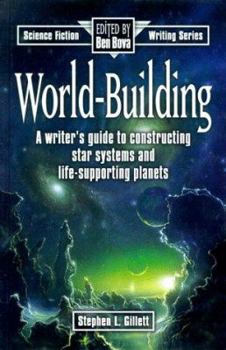Book Overview
Another in Ben Bova's series on Science Fiction Writing, here geologist and SF scribe Stephen Gillett helps you construct star systems and planets from the atoms up. While it may take you a little... This description may be from another edition of this product.
Format:Hardcover
Language:English
ISBN:0898797071
ISBN13:9780898797077
Release Date:January 1996
Publisher:Writer's Digest Books
Length:198 Pages
Weight:1.02 lbs.
Dimensions:0.8" x 6.2" x 9.3"
Customer Reviews
4 ratings
Concise, useful starting point.
Published by Thriftbooks.com User , 20 years ago
The biggest advantage to his book is that it concisely draws together the general facts about stars, planets, and atmospheres that one needs to design the physicality of worlds for hard-science fiction. Though not all encompassing or exhaustive of the subject, there's enough data to enable one to make choices for a world and then research those choices to the depth necessary to meet one's needs without having to become an expert in astrophysics and/or biochemistry.
Wow, I never thought of that!
Published by Thriftbooks.com User , 22 years ago
Ben Bova has helped to write several books in this series, including Aliens and Alien Societies, Time Travel, and this one, World-Building.This book gives the science fiction writer the science needed to create worlds on which your stories can unfold. As a scientist myself, I knew much of the information included, but there were more than a few times where I found myself saying "Wow, I never thought of that!".I'm sure there are a lot of writers out there who aren't scientists like me, and I'm sure they would benefit from having this information so that their worlds will not only be more realistic, they'll be scientifically plausible.
A Helpful Guide to Constructing Star Systems and Planets
Published by Thriftbooks.com User , 24 years ago
"World-Building" is the volume in the Science Fiction Writing Series edited by Ben Bova devoted to constructing star systems and life-supporting planets. Stephen L. Gillett has a doctorate in geology, was the science columnist at "Amazing Science Fiction" and has written SF under a pseudonym. My doctorate is in rhetorical studies, so I am starting at ground zero when it comes to understanding or at least appreciating the mathematical equations for escape velocity, scaling tidal forces or Roche's limit. While this book thoroughly convinced me that I have no aptitude for writing hard science, I can see how it would be extremely helpful to anyone interested in being on a strong scientific foundation when it comes to writing their own stories.Gillett's volume has eight chapters: (1) Why World-Build? looks at the necessity of using real science to create the requisite sense of wonder in your science fiction writing; (2) The Astronomical Setting covers the important differences between planets and stars in general and gravity, orbits, seasons and tidal action in particular; (3) Making a Planet details how the formation of a planetary system impacts the resulting planets and the options for story writing; (4) The Earth looks at the interconnected aspects that make interesting variations possible with the home worlds you create because of plate tectonics, water and air, magnetic field, colors, etc.; (5) The Ancient Earth deals with avoiding the "Cenozoic Earth Syndrome" (creating an alien world by making a few slight changes on ancient earth) by better understanding our ancient past as an inspiration for creativity; (6) The Other Planet looks at the wealth of data we have accumulated from our deep space probes as another source of inspiration; (7) Stars and Suns looks at how such heavenly bodies can supporting interesting planets as well; and (8) Not as We Know It discusses differences in volatile content (e.g., wetworlds, nitroworlds, brimstone worlds) as a final means of providing major scope for variation in words.Hopefully this will provide you enough information to decide if "World-Building" will help you in writing your own Science Fiction. I appreciate that for some people this book does not go far enough, but certainly for the vast majority of us it gives us enough information that we will not thoroughly embarrass ourselves when it comes to creating new worlds for our characters to inhabit and visit.
Unique in its beauty
Published by Thriftbooks.com User , 25 years ago
This is probably the best and only book that clearly states the current understanding of stars and formation/evolution of planets around them, in plain speech. The information is as extensive as it is scientifically accurate which is a great plus for an aspiring fiction writer who does not want to look over the countless pages of an Encyclopaedia Formulae on astrophysics. Besides the numerous formulas one needs to create a (scientifically) cohesive world, Gillett also gives many tidbits from the fiction writing over the course of time, allowing you to become familiar with the possibilities of several future technologies/discoveries. Also included are several studies of fictuous odd-ball worlds ( one is an ocean world filled with sulfuric acid). This book will likely be useful to the writer as well as the explorer within everyone.





